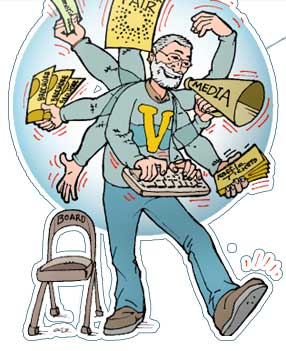








Doomsday
Clock Remains Close to Midnight
Brandon
Sun “Small World” Column, Monday, June 6 / 16
Zack Gross
Zack Gross
Last week, U.S. President Obama, in Japan for the G7 meetings, took time to visit Hiroshima and speak to the Japanese people about the nuclear bombing of that city and Nagasaki at the end of the Second World War. In 1945, the atomic scientists who worked on the Manhattan Project which produced those first nuclear weapons, created the Doomsday Clock, as they said that they could not ignore the consequences of their work.
At the time, the Clock was used as a lobbying tool to press for an end to the arms race and the threat of nuclear destruction of the Earth. Since 1945, the clock has been moved back and forth on an annual basis in relation to the fear this group of scientists endure as the world has careened through a long Cold War between Western allies and a Communist Empire which lasted from the 40s through to 1990 and now what some call Cold War II since Russia's invasion of Ukraine two years ago.
At the end of January of this year, the Bulletin of Atomic Scientists, a highly respected publication, announced that the clock would remain at three minutes to midnight as the threat of war and of climate change remain high despite on-going efforts such as a nuclear treaty with Iran and a climate accord in Paris. The clock was first set at 11.57 pm the previous January and remains the closest to midnight the sixteen Novel Laureates have set it since 1983 at the height of the Cold War.
Global tensions around current migration from the Middle East to Europe, on-going instability, terrorism and regional conflict in Western Asia, and an impasse between Russia and the U.S. over territorial expansion fuel the louder ticking of the Doomsday Clock. But with greater understanding of our climate challenges compared to the clock's inception 70 years ago, the scientists have added global warming as a factor in setting the Doomsday Deadline.
In their press release of late January of this year, the Scientists pointed out that 2015 was again Earth's warmest year, something that now occurs regularly. We are now on average more than a degree Celsius warmer than we were in pre-industrial times, which makes a seemingly small but actually devastating difference to the planet. At no time in our history have we dealt with extreme weather as we are now forced to – storms, floods, droughts on a scale that were of-the-century, then of-the-decade and now everyday happenings.
While the Atomic Scientists see glimmers of hope in Canada and Australia re-engaging in climate discussions, they are discouraged that the British government is headed in the opposite direction, and that the U.S. Republican Party now stands alone in failing to acknowledge that human-caused climate change is even a problem. On the positive side, they recognize the value of the Papal Encyclical on Climate Change and the creation of new, greener technologies and investments by the private sector.
Echoing the concerns of the architects of the new United Nations Sustainable Development Goals announced at the start of this year, when it comes to climate change, voluntary and incremental measure just aren't enough! There needs to be fundamental change to turn the tide of global warming. Fear around U.S.-Russian relations and North Korean nuclear initiatives lead the scientists to say that only a few bright spots kept the clock from being moved even closer to midnight.
World leaders are called upon to dramatically reduce spending on their nuclear weapons modernization programs (something many of us don't know about!) and to follow up with action immediately on the Paris Climate Accords. Say the keepers of the Doomsday Clock: “The Clock Ticks. Global Danger Looms. Wise Leaders Should Act Immediately.”
Zack Gross is a former Executive Director of Brandon’s The Marquis Project.
* * * * *
Return to Articles page
Return to Articles page